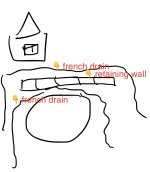I'm thinking about building an above ground pool on an elevated pad with trenches surrounding it for rainwater drainage. Our backyard is very flat and we get heavy rain sometimes resulting in lots of standing water. It does flow in one direction, just pretty slowly.
Due to the lack of any notable "high ground" on my property, I was thinking the best way to prevent standing water under the pool might just be to simply elevate the pad a few inches above grade and collect excess water in a trench around the pool leading to a low point where it could drain into the ground.
I attached a picture showing my vision. Is it overkill?
Just looking for advice, best practices, and I'm not married to the arrangement laid out above. Totally open to better options.
Due to the lack of any notable "high ground" on my property, I was thinking the best way to prevent standing water under the pool might just be to simply elevate the pad a few inches above grade and collect excess water in a trench around the pool leading to a low point where it could drain into the ground.
I attached a picture showing my vision. Is it overkill?
Just looking for advice, best practices, and I'm not married to the arrangement laid out above. Totally open to better options.




